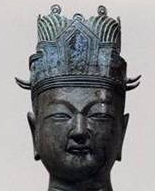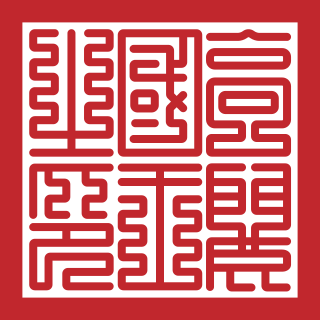Related Research Articles

Taebong was a state established by Gung Ye on the Korean Peninsula in 901 during the Later Three Kingdoms.

Gung Ye was the king of the short-lived state of Taebong (901–918), one of the Later Three Kingdoms of Korea. Although he was a member of the Silla royal family, he became a victim of the power struggle among the royal family members during the late 9th century. He became a rebel leader against the unpopular Silla government, which almost abandoned the affairs of their subjects for the struggle for power among royal family members.

Taejo of Goryeo, also known as Taejo Wang Geon, was the founder of the Goryeo dynasty, which ruled Korea from the 10th to the 14th century. Taejo ruled from 918 to 943, achieving unification of the Later Three Kingdoms in 936.

The House of Wang was the royal ruling house of the Goryeo dynasty (918-1392) of Korea.
Hyejong of Goryeo was the second King of Goryeo. He was preceded by King Taejo and succeeded by Jeongjong, 3rd Monarch of Goryeo.

Taejo Wang Geon is a 2000 Korean historical period drama. Directed by Kim Jong-sun and starring Choi Soo-jong in the title role of King Taejo. The drama aired from April 1, 2000 to February 24, 2002 in a total of 200 episodes. In the scene dealing with the end of Gungye, it gained a lot of popularity, recording the highest viewership rating of 60.4% in the metropolitan area.
Princess Hwahyeop, or Princess Hwahyop was the seventh daughter of King Yeongjo of the Joseon dynasty in Korea.
Wang Ryung, also known as Wang Yung, was a Korean hojok, or local regional lord of Song-ak, who lived during the Later Three Kingdoms period. He was the father of Wang Geon, the founder of the Goryeo dynasty. He was later posthumously honoured with a temple name of Sejo and a posthumous name of King Wimu the Great by his descendants.

Dream of the Emperor is a South Korean television series that aired on KBS1 from September 8, 2012 to June 9, 2013 on Saturdays and Sundays at 21:40 for 70 episodes.

Happy Home is a 2016 South Korean television series starring Kim Yeong-cheol, Won Mi-kyung, Kim So-yeon, Lee Sang-woo and Lee Pil-mo. It aired on MBC every Saturdays to Sundays at 20:45 (KST) for 51 episodes from February 27 to August 21, 2016.
Queen Sindeok, of the Goksan Kang clan, was a posthumous name bestowed to the second wife and queen consort of Yi Dan, King Taejo; the first monarch of the Korean Joseon Dynasty. She was queen consort of Joseon and was honoured as Queen Hyeon (현비) from 1392 until her death in 1396. She was a political advisor of King Taejo and had a great influence on the founding of Joseon. She was posthumously called as Sindeok, the High Empress.

Queen Janghwa of the Naju Oh clan was the second Goryeo queen consort through her marriage as the second wife of Wang Geon, its founder and became the mother of his heir and oldest son, King Hyejong.
Queen Sinhye of the Chŏngju Yu clan was the first Goryeo queen consort through her marriage as the first wife of Wang Geon, its founder. As the wife and mother of the new nation, she supported her husband's national affairs with a good plan and received great favor and preferential treatment from many people, also become his favourite wife.
Queen Jeonghwa of the Sincheon Gang clan, personal name Gang Jin-ui, was the second daughter of Gang Bo-yuk who would become the great-grandmother of Wang Geon, founder of the Goryeo dynasty. As a figure from the Later Silla period, she is the first one from among the ancestors of King Taejo to be accurately reported by the left records.
Lady Sinjuwon of the Sincheon Gang clan was the daughter of Gang Gi-ju who became the 23rd wife of Taejo of Goryeo.
Lady Uiseongbuwon of the Uiseong Hong clan was the daughter of Hong-Yu who became the 27th wife of Taejo of Goryeo. Her father was one of the helper and supporter for Wang Geon in established the new Goryeo dynasty along with Sin Sung-gyeom (신숭겸), Bak Ji-gyeom (복지겸) and Bae Hyeon-gyeong (배현경), also they all defeated Gung Ye. Hong-Yu also served Taejo as his Three Grand Masters (삼중대광) and with Taejo, she had a son, Grand Prince Uiseongbuwon who later married Lady Ryu, 3rd daughter of Queen Jeongdeok.
Lady Heungbokwon of the Hongju Hong clan was the daughter of Hong-Gyu, Hongju Hong clan 's founder. who became the 12th wife of Taejo of Goryeo.
Yu Cheon-gung or also known as Local Chief Yu was a rich-nobleman in the Later Three Kingdoms Period who became the father of Queen Sinhye and father in-law of Wang Geon, Goryeo dynasty's founder.
Queen Sinmyeong of the Chungju Yu clan or long-called as Queen Sinmyeongsunseong was the third Goryeo queen consort through her marriage as the third wife of Wang Geon, its founder and become the mother of his 5 sons and 2 daughters.
The Chŏngju Yu clan (Korean: 정주 유씨; Hanja: 貞州 柳氏 is a Korean clan. Their Bon-gwan is Chŏngju, in modern-day Kaepung, Kaesong. It was founded by Yu Cheon-gung who was a nobleman from Chŏngju and served as one of the Three Major Grand Masters.
References
Citations
- ↑ From many Korean Queens who have their own royalty names which different from their clans, there was exception for the three queens that simply called with their clan/surname and "queen/consort" (비, 妃). They were: Queen Kang (her, 강비); Queen Jo (King Chungseon's wife, 조비); and Queen Min (King Gojong's wife, 민비). Although Jo and Min were called like that, but they still received some honorary/posthumous name not like Kang who didn't receive any of that.
- ↑ 월간 중앙 (in Korean). University of California: Jungang Ilbo. 2000. p. 345.
- 1 2 Seo Gu-jung, Park Hong-kap (2012). 필원잡기 (in Korean). CommunicationBooks. ISBN 9791130434292.
- ↑ Doo-jin, Kim (1996). "궁예". encykorea.aks.ac.kr (in Korean). Encykorea . Retrieved June 28, 2021.
- ↑ Samguk Sagi,Book 50,Gungye "貞明元年,夫人康氏以王多行非法,正色諫之。王惡之曰:「汝與他人奸,何耶?」康氏曰:「安有此事?」王曰:「我以神通觀之。」以烈火熱鐵杵撞其陰殺之,及其兩兒。"
- ↑ Sinya, Kang (1989). 간신 의 처 [Barely A Wife] (in Korean). University of Michigan: Literary World Club. p. 173.
- ↑ Ki-duk, Kim (2005). 영상역사학 (in Korean). University of Michigan: 생각의나무. p. 125. ISBN 9788984984776.
- ↑ < "철원군에 있었던 태봉국의 시작과 끝". Local culture story (in Korean). Retrieved April 23, 2022.
- ↑ Sisa chŏnŏl, Volumes 534-539 (in Korean). University of California: Kukche Ŏllon Munhwasa. 2000.
- ↑ Kwang-soo, Lee (2013). 이광수 문학전집 소설 8- 마의태자 [A Collections of Lee Kwang-soo novel 8- Crown Prince Maui] (in Korean). SINYUL. ISBN 9788966980208.
- ↑ 월간 중앙, Volume 26, Issues 6-7 [Monthly Joongang, Volume 26, Issues 6-7] (in Korean). University of California: Joongang Ilbo. 2000. pp. 231, 345.
- ↑ "비운의 여인KBS 대하드라마 태조 왕건 강비역 김혜리". Hankyung News (in Korean). 17 March 2000. Retrieved April 23, 2022.
- ↑ "태조 왕건' 그들의 최후". The Korea Times (in Korean). 22 May 2001. Retrieved April 23, 2022.
- ↑ In this series, the Queen appears with name Kang Yeon-hwa (강연화).
- "[연예가 소식]김혜리 '태조 왕건' 강비역 캐스팅". The Dong-a Ilbo (in Korean). March 1, 2000. Retrieved June 27, 2021.
- "[방송]<태조왕건>,황후 '연화'의 비참한 최후". The Dong-a Ilbo (in Korean). May 2, 2001. Retrieved June 27, 2021.
- "[방송.연예] '태조 왕건' 강비역에 김혜리 선정". The Busan Ilbo (in Korean). Retrieved June 27, 2021.
- ↑ Firstly lived in Buso Mountain and later moved to Songak; son of General Seonggol (성골장군) who travelled Baekdu Mountain and settled in Buso Mountain, Songak (송악).
- ↑ She came from the wealth Gu family clan in Western River, Yeongan Village.
Further reading
- Ilyon (2006). Samguk Yusa. Disruptive Publishing. ISBN 9781596543492.
- Kim Yong-sun (2008). "궁예의 나라 태봉". (in Korean). Iljogak. Retrieved June 28, 2021.